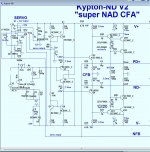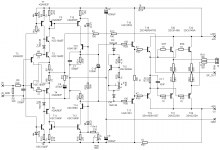What is the full part number for those parts? If it is the Fairchild number than they are Fairchild transistors as OnSemi has acquired Fairchild.
EDIT: Oh, I see it is Onsemi and Fairchild
Is that with the collector open or closed?
EDIT: Oh, I see it is Onsemi and Fairchild
Is that with the collector open or closed?
Last edited:
Collector floating in the air...
my bc550 are bought before onsemi incorporated fairchild.
BR, Toni
my bc550 are bought before onsemi incorporated fairchild.
BR, Toni
The measurements indicate an Rb of about 9 ohms, which is inconsistent with the known Rb of around 167ohm. Since Rb is a diffused semiconductor resistance, it's value changes so maybe it really is 9ohm in reverse breakdown.
The problem is that if this is true, the models won't be good for much except Vbe breakdown.
The problem is that if this is true, the models won't be good for much except Vbe breakdown.
I see what you mean - Q7 reverse EB breakdown is approached...
Is there any such problem with a conventional EF assisted VAS, cascode on the IPS, as Damir uses?
The B.x&all pair looks clever but Damir is correct, the only improvement in Return Ratio is at low frequency where it hardly matters.
Maybe save a lot of trouble with models and circuits at no real penalty, THD @ 20k will be practically identical.
Best wishes
David
Also, has anyone looked to replace the level shift transistors in the IPS with diodes?
The BC550/560 are a bit noisy and it would be nice to remove them.
I have seen this done in CFA ICs, but I don't know if there is a suitable discrete diode.
Any recommendations welcome.
Best wishes
David
The BC550/560 are a bit noisy and it would be nice to remove them.
I have seen this done in CFA ICs, but I don't know if there is a suitable discrete diode.
Any recommendations welcome.
Best wishes
David
Is there any such problem with a conventional EF assisted VAS, cascode on the IPS, as Damir uses?
The B.x&all pair looks clever but Damir is correct, the only improvement in Return Ratio is at low frequency where it hardly matters.
Maybe save a lot of trouble with models and circuits at no real penalty, THD @ 20k will be practically identical.
Best wishes
David
Don't say I did not try it.
The return ratio at 20K slightly suffers. (below)
This basic IPS was actually prototyped by my friend in Greece.
We did 3 variants
1. Just a plain non-enhanced EF VAS. Good basic CFA.
2. Beta enhanced EF , the best slew rate ... nearly as good THD as the boxall.
Had to use 2 X double red led's in the CCS's to offset the VAS thermal
co-efficient.
3. Finally got to the "kypton ND" (this design-below #2). Could run it at 4.xx mA
and get the same (or better) performance than # 2 above. Slightly slower
slew rate but higher 20khz margin.
The double led's in the cascode negated the diamond / current mirror thermals.
The CM's were also the basis for the DC servo.
I used this IPS from 10C-40C , clipped it for parties ... abused it literally -
tried to blow it up.
Well thanks everyone , I have been enlightened to the 39Mhz peak and the reverse BE issue.
I'm quite confident it would be even less likely to fail in it's present form.
PS- BCxxx noise ?? I did did not hear any noise. My Greek builder had - @ < -110db noise floor
in testing. NO Jfets !! 😀😀
OS
Attachments
Last edited:
Noise floor levels in amplifier specs tend to be surprisingly high because of the standard used. The noise is measured at 1Hz bandwidth using 1W->8ohm=2.83V as the reference.
So DIYers tend to do 2 things that make their noise floors appear far better than standardized specs. The first thing is they use a large FFT which has better than 1Hz bandwidth. The second thing is they use full power as the reference which is much larger than 2.83V.
I think the standard is more applicable to casual listening.
To find the standard noise spec in LTspice you would do a .noise analysis from 20-20KHz, then ctrl-click on the output noise trace name. This will give you the RMS voltage noise at the output within the audio range. Then you do 2.83Vrms/Vnoise which results in a number along the lines of 89db which sounds pathetic but is possibly more realistic and allows you to compare it with other amplifiers.
A-weighting or other psychoacoustic weighting is often also applied.
So DIYers tend to do 2 things that make their noise floors appear far better than standardized specs. The first thing is they use a large FFT which has better than 1Hz bandwidth. The second thing is they use full power as the reference which is much larger than 2.83V.
I think the standard is more applicable to casual listening.
To find the standard noise spec in LTspice you would do a .noise analysis from 20-20KHz, then ctrl-click on the output noise trace name. This will give you the RMS voltage noise at the output within the audio range. Then you do 2.83Vrms/Vnoise which results in a number along the lines of 89db which sounds pathetic but is possibly more realistic and allows you to compare it with other amplifiers.
A-weighting or other psychoacoustic weighting is often also applied.
Don't say I did not try it.
The return ratio at 20K...
I am pretty confident I can optimize the return ratio.
The question is about the over load reverse bias that people have posted about in the last few days.
Is this a problem only for the B.x&ll pair or does it occur with the standard EF assisted VAS?
BCxxx noise ?? I did...not hear any noise...
Your speakers may be less efficient.
I plan this for my compression driver bi-amps, that makes them about 20dB more sensitive than typical mids, and they are not padded down by a passive crossover.
So the BC550/560 sounds fine for you but I am pretty sure I can better - without any real downside.
Best wishes
David
For a EF assisted VAS there is nothing to make Vbe go negative, although the base can be overdriven if there is no limiting. We hope that the datasheet provides max base current guidelines.
Your speakers may be less efficient.
I plan this for my compression driver bi-amps, that makes them about 20dB more sensitive than typical mids, and they are not padded down by a passive crossover.
So the BC550/560 sounds fine for you but I am pretty sure I can better - without any real downside.
Best wishes
David
Dayton DCF28 tweeter = 89db
Dayton DS215 woofer = 89.9db
I only use these for 100-20khz.
My class D POLK 12" is the bass.
I know 89db is mediocre efficiency. The small greenamp ( 4 device)
should power the dayton's well.
Yes , there is better silicon out there. 550/560 are easy to source- globally.
OS
To find the standard noise spec in LTspice you would do a .noise analysis from 20-20KHz, then ctrl-click on the output noise trace name. This will give you the RMS voltage noise at the output within the audio range. Then you do 2.83Vrms/Vnoise which results in a number along the lines of 89db which sounds pathetic but is possibly more realistic and allows you to compare it with other amplifiers.
Paste the directives. (show example).
OS
Also, has anyone looked to replace the level shift transistors in the IPS with diodes?
The BC550/560 are a bit noisy and it would be nice to remove them.
I have seen this done in CFA ICs, but I don't know if there is a suitable discrete diode.
Any recommendations welcome.
Best wishes
David
There can be a problem with the input impedance, and the DC offset. I use same input, and my amplifier dead silent with 90dB/W loudspeaker, even put your ear close to the HF driver.
Sajti
Attachments
... FFT which has better than 1Hz bandwidth...they use full power as the reference
Yes, I am not interested in visual tricks to make the specs look better.
I usually work in nV/rt(Hz).
To find the standard noise spec in LTspice you would do a .noise analysis from 20-20KHz, then ctrl-click on the output noise trace name...
I did the .Noise analysis but I didn't remember the cntrl-click short cut, thanks.
Best wishes
David
Last edited:
There can be a problem with the input impedance, and the DC offset.
DC offset is OK, I will check the input impedance, thanks
I use same input, and my amplifier dead silent with 90dB/W loudspeaker...
I have 115 dB/W😉
So you can see why I take care here.
Best wishes
David
For a EF assisted VAS there is...
Yes, that was my expectation, just wanted to check I hadn't missed any scenario.
So I am inclined to skip all the issues of the "super pair" and stay with the EF pair.
Best wishes
David
DC offset is OK, I will check the input impedance, thanks
I have 115 dB/W😉
So you can see why I take care here.
Best wishes
David
115dB/W for home hifi? You can maybe destroy your home with 100W....
My amp has a noise 52.2nV/Hz1/2-.
Sajti
115dB/W for home hifi? You can maybe destroy your home with 100W...
It's only the mids that are so efficient, so won't destroy my home, and I am careful of levels to save my ears.
They are actual theatre drivers rather than home theatre so they are overkill but the price was reasonable and I never have to worry if they will clip
Dayton DCF28 tweeter = 89db
Yes , there is better silicon out there. 550/560 are easy to source
Yes, but it's still easy to source the better stuff.
Best wishes
David
It's only the mids that are so efficient, so won't destroy my home, and I am careful of levels to save my ears.
They are actual theatre drivers rather than home theatre so they are overkill but the price was reasonable and I never have to worry if they will clip
Yes, but it's still easy to source the better stuff.
Best wishes
David
David, what would be your choice?
Any recommendation of easy to get better parts as BC550C/560C - no jfet please! 😉...
Yes, but it's still easy to source the better stuff.
...
Through hole preferred, but SMD also welcome.
BR, Toni
David, what would be your choice?
Any recommendation...?
"The Art of Electronics" 3rd edition (by DIYaudio member Winfield Hill) has a nice table of low noise transistors.
His lowest noise measurement is not actually advertised as "low noise", just has really low Rb because it's optimised for low loss at substantial current, medium power
- the Zetex ZTX851 and ZTX951 complement, and even thru hole!
Readily available from the distributors, on cut tape so minimum order is 1, Mouser has hundreds, thousands more on order, D.Key has thousands.
Cost is about $1, less in quantity, so it's a little more but trivially so.
Gain is lower, as you would expect from a power optimised device but it's still Hfe=200 typical so should be no problem.
I am still at work on the simulation so I will try it and see, if not there's a lot of other transistors in the list that do better than the old 550/560.
I actually have a stash of 2sa1316/2sc3329 which are thru hole, ultra low noise with excellent measured Hfe = 375.
But they are now unavailable, so not useful for a project to share, I may use them for my "Unobtainitron" 😉
Best wishes
David
Last edited:
- Status
- Not open for further replies.
- Home
- Amplifiers
- Solid State
- GreenAmp ++ modulated Class G output


